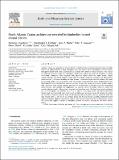Files in this item
North Atlantic Craton architecture revealed by kimberlite-hosted crustal zircons
Item metadata
| dc.contributor.author | Gardiner, Nicholas J. | |
| dc.contributor.author | Kirkland, Christopher L. | |
| dc.contributor.author | Hollis, Julie A. | |
| dc.contributor.author | Cawood, Peter A. | |
| dc.contributor.author | Nebel, Oliver | |
| dc.contributor.author | Szilas, Kristoffer | |
| dc.contributor.author | Yakymchuk, Chris | |
| dc.date.accessioned | 2020-01-29T09:30:08Z | |
| dc.date.available | 2020-01-29T09:30:08Z | |
| dc.date.issued | 2020-03-15 | |
| dc.identifier | 266070594 | |
| dc.identifier | 6b0039d4-3f64-45a2-bdfe-9cda3e5ea970 | |
| dc.identifier | 85077932606 | |
| dc.identifier | 000515198200022 | |
| dc.identifier.citation | Gardiner , N J , Kirkland , C L , Hollis , J A , Cawood , P A , Nebel , O , Szilas , K & Yakymchuk , C 2020 , ' North Atlantic Craton architecture revealed by kimberlite-hosted crustal zircons ' , Earth and Planetary Science Letters , vol. 534 , 116091 . https://doi.org/10.1016/j.epsl.2020.116091 | en |
| dc.identifier.issn | 0012-821X | |
| dc.identifier.other | RIS: urn:7B28006A8A7A712182FF47C1F9C2D8D1 | |
| dc.identifier.other | ORCID: /0000-0003-3465-9295/work/68281984 | |
| dc.identifier.uri | https://hdl.handle.net/10023/19368 | |
| dc.description | The Maniitsoq project is supported by the Ministry of Mineral Resources, Government of Greenland. NJG and PAC thank Australian Research Council grant FL160100168 for financial support. ON is supported by Australian Research Council grant FT140101062 and the Melbourne TIE team. | en |
| dc.description.abstract | Archean cratons are composites of terranes formed at different times, juxtaposed during craton assembly. Cratons are underpinned by a deep lithospheric root, and models for the development of this cratonic lithosphere include both vertical and horizontal accretion. How different Archean terranes at the surface are reflected vertically within the lithosphere, which might inform on modes of formation, is poorly constrained. Kimberlites, which originate from significant depths within the upper mantle, sample cratonic interiors. The North Atlantic Craton, West Greenland, comprises Eoarchean and Mesoarchean gneiss terranes – the latter including the Akia Terrane – assembled during the late Archean. We report U–Pb and Hf isotopic, and trace element, data measured in zircon xenocrysts from a Neoproterozoic (557 Ma) kimberlite which intruded the Mesoarchean Akia Terrane. The zircon trace element profiles suggest they crystallized from evolved magmas, and their Eo- to Neoarchean U–Pb ages match the surrounding gneiss terranes, and highlight that magmatism was episodic. Zircon Hf isotope values lie within two crustal evolution trends: a Mesoarchean trend and an Eoarchean trend. The Eoarchean trend is anchored on 3.8 Ga orthogneiss, and includes 3.6–3.5 Ga, 2.7 and 2.5–2.4 Ga aged zircons. The Mesoarchean Akia Terrane may have been built upon mafic crust, in which case all zircons whose Hf isotopes lie within the Eoarchean trend were derived from the surrounding Eoarchean gneiss terranes, emplaced under the Akia Terrane after ca. 2.97 or 2.7 Ga, perhaps during late Archean terrane assembly. Kimberlite-hosted peridotite rhenium depletion model ages suggest a late Archean stabilization for the lithospheric mantle. The zircon data support a model of lithospheric growth via tectonic stacking for the North Atlantic Craton. | |
| dc.format.extent | 2422640 | |
| dc.language.iso | eng | |
| dc.relation.ispartof | Earth and Planetary Science Letters | en |
| dc.subject | lamprophyre | en |
| dc.subject | Archean Archaean | en |
| dc.subject | Greenland | en |
| dc.subject | Itsaq Isua | en |
| dc.subject | Isukasia Akia Terrane | en |
| dc.subject | SCLM lithosphere mantle | en |
| dc.subject | GE Environmental Sciences | en |
| dc.subject | QE Geology | en |
| dc.subject | DAS | en |
| dc.subject.lcc | GE | en |
| dc.subject.lcc | QE | en |
| dc.title | North Atlantic Craton architecture revealed by kimberlite-hosted crustal zircons | en |
| dc.type | Journal article | en |
| dc.contributor.institution | University of St Andrews. School of Earth & Environmental Sciences | en |
| dc.identifier.doi | https://doi.org/10.1016/j.epsl.2020.116091 | |
| dc.description.status | Peer reviewed | en |
This item appears in the following Collection(s)
Items in the St Andrews Research Repository are protected by copyright, with all rights reserved, unless otherwise indicated.

